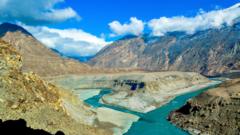India's recent suspension of the Indus Waters Treaty sparks questions about its capacity to control river flows to Pakistan. Experts indicate significant infrastructural and geographical challenges hinder India's ability to effectively manage water flow, despite potential legal leeway.
India's Water Control Dilemma: Can It Halt Flow to Pakistan?

India's Water Control Dilemma: Can It Halt Flow to Pakistan?
Amid heightened tensions, India considers suspending the Indus Waters Treaty, prompting concerns about its ability to divert river waters to Pakistan.
The Indus River, a lifeline for both India and Pakistan, is at the center of a tense geopolitical situation following India's suspension of a critical water-sharing treaty. This decision follows a series of escalations in Kashmir and raises concerns about whether India can legally and practically halt the river's flow to Pakistan, which relies heavily on the Indus basin for agriculture and hydropower.
The Indus Waters Treaty (IWT), established in 1960, was designed to manage water distribution between the two nuclear-armed neighbors, specifically splitting the river's flows; India was allocated the three eastern rivers—Ravi, Beas, and Sutlej—while Pakistan received the western rivers, including Indus, Jhelum, and Chenab. Amid ongoing accusations from India claiming Pakistan supports cross-border terrorism, the suspension of this treaty has sparked fears of water-related conflicts, with Pakistan warning that any attempts to stop water flow may be viewed as an "Act of War."
Experts assert that while India may seek to modify its approach to water management, physically preventing water from flowing into Pakistan is fraught with complications. India's existing infrastructure primarily consists of run-of-the-river hydropower plants, which do not allow for significant water storage. According to Himanshu Thakkar, a water resource expert, the country lacks the necessary storage capabilities to effectively divert the substantial volumes of water that flow through the Indus basin, especially during periods of high flow.
Despite the geographical advantage of being upstream, India's ability to impact water flow significantly remains doubtful. While the country can potentially amend its existing infrastructure to better manage flow without notifying Pakistan, any meaningful construction has been hampered by factors such as terrain challenges and public opposition to dam projects. Moreover, experts point out that although India might not be required to share detailed project documents under current treaty conditions, the implications of such changes are yet to be seen.
Pakistan's agriculture and hydroelectricity are deeply tied to the available water supply from the Indus and its tributaries, with the dry season being a particular concern. Analysts warn that if India were to manipulate water flows, Pakistan could experience dire shortages during critical periods. The treaty's requirements for India to share hydrological data are also under scrutiny, with past claims suggesting incomplete data sharing.
Discussion also arises around the concept of "weaponizing" water, as the threat of flooding areas due to sudden water release poses risks to both sides, though primarily to India's own territories. The complexity of the situation is heightened by China's position upstream in the Brahmaputra basin, raising the stakes in the current water-sharing disputes in South Asia. As both countries grapple with these issues, the Indus river will continue to be a significant point of contention in their tumultuous relationship.


















